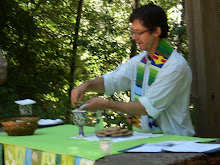To begin with, there was that
puzzling telegram—there, in the scrapbook with the snapshots of me as a baby, along
with my tiny footprints, and the lock of my first hair—a telegram from my
mother’s parents that read “Congratulations on the birth of another fine
grandson.” Only, looking through the
book as I often did when I was a child, I couldn’t help but noticed that it was
addressed to my mother as Dusty Griffiths,
which was the last name of my mother’s first husband. I knew, of course, that she had been married
before, and that my two older brothers had a different name and a different
father, the man they called “Daddy John.”
He wrote them letters and sent them presents, and they would go off sometimes
to visit him in exotic places like Seattle, and New York City, and Ghana, West Africa.
So I pondered that telegram, and
wondered about how I came to be born eighteen months after my brother Ben, to a
different father, on the opposite coast of the United States. But no one explained it, and I didn’t
ask. Until I was sixteen years old, and home
for the summer before going off to college, and one morning when my mom and I
were alone in the house she sat me down and told me the story. A story about how she was in New Haven,
Connecticut where she knew no one, and her husband would leave her alone with
the baby almost every evening and every weekend and go off to Greenwich Village
with his old boarding-school girlfriend or his law-school classmates; about how,
as his professional star began to rise, he treated her more and more as a
domestic servant, speaking to her as if she were stupid. She wrote desperate letters to her parents,
begging to come home to California, and was told that her first duty was to her
husband and that she had to tough it out.
Somewhere along the line, she began
corresponding with a man with whom she’d had known years before, when she had
just graduated high school. He was a
seminary student named Alan Green, her older brother’s youth group leader at
their church in Berkeley. And she and
Alan had a brief love affair, which he broke off, because he was nine years her
senior. But apparently the torch never entirely
went out, because when my mother announced to her parents on a visit home, that
she was filing for divorce and would not be returning to New Haven, and they
told her to get out of their house, it was Alan Green who drove up from
Southern California and brought her and her two babies home to live with him.
That’s some of the story about why
that name is on the telegram, and how it was that, at one year of age, I
attended my parents’ wedding. It’s not
an entirely happy story, and I’m not going to pretend that everything was wine
and roses from that point on. But it
worked out okay for me, and for better or worse my parents will celebrate their
47th anniversary later this week.
We all have to get into this world somehow, and none of us gets to
choose how that will be. And if the
circumstances are a little scandalous, or are the consequence of questionable
choices, that doesn’t really matter to God.
God wants us here for her own reasons, and doesn’t let human scruples
about morals stand in the way.
The Gospel of Matthew begins with a
genealogy of Jesus Christ. Like other
genealogies in the bible, this is a long recitation of the names of fathers and
sons. But along with the male ancestors
of Jesus, Matthew also mentions five women. The first of these women is Tamar, who was
the daughter-in-law of Judah, one of the twelve sons of Jacob. Tamar was the childless widow of first one,
and then another of Judah’s sons, and she disguised herself as a prostitute to
trick her father-in-law into getting her pregnant, so the family line would
continue. The next woman in the
genealogy is Rahab, who really was a prostitute, and who harbored Joshua’s
spies in Jericho and paved the way for Israel’s conquest of Canaan by betraying
her own people.
Rahab was also the mother of Boaz,
who married the next woman to appear on the list, Ruth. Ruth was married to an Israelite living in
Moab, and when her husband died she went with her mother-in-law back to the
land of Judah, to Bethlehem, where she deliberately, and somewhat deviously, won
the affections of a leading man of the town.
Boaz and Ruth were grandparents of David, who had an adulterous affair
with the wife of Uriah the Hittite, otherwise known as Bathsheba. David had her husband killed, and took her as
one of his wives, and it was she who, through palace intrigue at the time of
David’s dying, ensured that her son Solomon would succeed him on the throne. And yes, she’s also on the list.
Tamar, Rahab, Ruth, and Bathsheba—four
women who show the lengths you have to go to at times, the courage and ingenuity
it takes, the willingness to endure scandal and shame that are sometimes
required, to advance the mission of God in the world. And the fifth woman in the genealogy of Jesus
is Mary, his mother. But Matthew tells
her story with the spotlight on her husband Joseph. Joseph found that Mary was bearing a child
not his own. Being unwilling to expose
her public disgrace, he resolved to break off the engagement quietly. Matthew says this was because he was a “righteous
man.” So the righteousness of Joseph
must have more to do with going with your gut than following the rules, more to
do with forgiveness than with judgment, more to do with compassion than with
being morally correct.
God ups the ante on Joseph, and sends
an angel who instructs him to take Mary as his wife. And so he takes the disgrace of Mary upon himself. As readers of the Gospel, we are in on the secret,
but to Joseph’s family and the neighbors next door, and all the gossips in town
he is a righteous man disgraced, marrying a woman who is already carrying a
child. And here we have, in a nutshell, the
paradox that stands before us at the threshold of Christmas—that the birth of
the Messiah, the long-awaited Emmanuel, “God-with-us,” is a scandal, an event
as disruptive to the “right way” things are supposed to be done as an unplanned,
unmarried pregnancy.
Throughout the New Testament the
gospel of Jesus Christ is salvation and scandal at the same time. You can see this when Jesus touches the
ritually unclean, the lepers, the demon-possessed, and says that their faith
has saved them. You can see it when he eats
with tax-collectors and prostitutes as a sign of the kingdom, and the solid
citizens call him a glutton and a drunkard.
You can see it when he sits down on the mountain and preaches that
righteousness is not a stamp of approval, but a hunger and a thirst, and those
who know how desperately they need it are already blessed, because they will be
satisfied. You can see the salvation
that is also a scandal in starkest relief on the cross. But in Matthew you can also see it at the
very beginning of the story, in the manner of Jesus’ birth, and even before that,
in the stories of the women in his family tree.
As we prepare again for Christmas,
we may feel some pressure to have things look the “right way.” But our holiday gatherings may bring painful
reminders of how our own family trees are bent or broken, and we may wonder anew how we
managed to grow from such strange stock.
Maybe we ourselves are a scandal to people who ought to love us, and Christmas
sharpens our hunger and thirst for the righteousness that is forgiveness and
compassion and love. Or maybe we are all
that remains of our families, one last living branch on a withered tree. Maybe as we come together as a congregation
this Christmas we remember that it was seven years ago today that our parish was
torn by schism.
Maybe we compare our lives to what
we think Christmas is supposed to be like, and the comparison isn’t a favorable
one. But the message of the gospel is
that we don’t have to choose between scandal and salvation. In fact, we don’t get to. In Christ God has made them one and the same. And after all, “Emmanuel” doesn’t mean “God
with the right people,” or “God with the deserving people,” or even “God with
the good people.” It means “God with us.”




